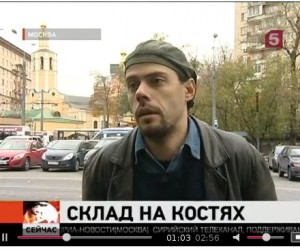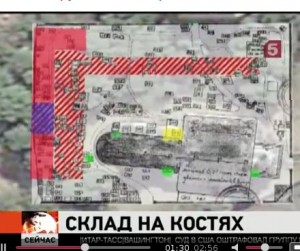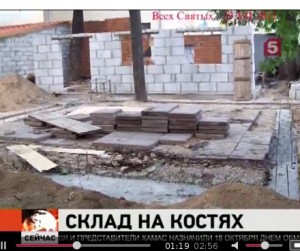
TBILISI, DFWatch – The Georgian foreign ministry ignored calls from an activist in Moscow to help stop the destruction of a historic cemetery where royals, nobles and famous persons are buried.
All Saints Cemetery contains the graves of Russian and Georgian nobles and royals, but has undergone a gradual decay since the late 19th century. In July 2011, an activist in Moscow raised the alarm about a new brick building being put up on top of the historic soil.
Georgia’s foreign ministry in April this year picked up on what was happening and sent an official protest to Russia.
In what is called a diplomatic note, a strong form of protest in the world of diplomacy, sent via Swiss mediators, the ministry requested a halt to new construction work on the All Saints cemetery, asked for information and asked to rebury historic persons in Georgian soil.
But the protest came too late, as the construction work had already been stopped, according to Georgiy Ramazashvili, an archival researcher and freelance journalist who grew up in the vicinity of the cemetery, and was the first to report that there was new construction work there last summer.
He raised the alarm by contacting media both in Russia and Georgia, but also wrote emails and called authorities in Tbilisi to ask for help in stopping what was going on.
But while Georgian authorities were making appearances on government-controlled TV promising action, in reality they did nothing, he says. Only after the destruction had been stopped, did they take action.
-Construction work was stopped back in September. With no help from official Tbilisi. And now the bureaucracy pretends that they are trying to do something I have successfully done half a year ago, says Ramazashvili.
To raise awareness, he went on Russian TV in a report which can be viewed here, and in the end, he managed to stop the construction without help from the government in Tbilisi.
-The funny thing is that this [diplomatic] note could and would have been necessary and extremely useful just seven months ago when we were trying to put pressure on the Department of Cultural Heritage of Moscow to stop the construction work, Ramazashvili says.
He says Moscow authorities had intervened and stopped work on the site, reacting to his pleas, but that he was not sure whether this was a temporary decision. It wasn’t until February 2012 that he received written confirmation from the monument division in Moscow municipality about a halt to the development. Until then, Tbilisi’s involvement would have been helpful.
But neither the Georgian foreign ministry nor the culture ministry’s department for protection of monuments did anything to help him in his effort to stop what was going on.

-If officials wanted to affect the situation and help, they should have started acting not in April, but in October when they saw the story in TV news programs, he says.
He says he informed the Georgian Culture Ministry’s Department for Monuments Protection about the situation not later than October 2011, but that he never heard back from them.
When DF Watch visits the department for protection of monuments, a branch of Georgia’s culture ministry, no-one is able to provide us information about what role its staff have played in this case. The department’s PR manager refuses to let us quote her and says nobody is available to talk about the issue of Georgia’s diplomatic protest to Russia. She says that is not her department’s responsibility.
One of the academic staff, Giorgi Gagoshidze, says he and an external consultant who does not work at the department, Givi Ghambashidze, are planning to prepare a document about the cemetery’s current condition, which they will send to the foreign ministry when they are finished.
The foreign ministry, which refuses to communicate with us in any other way than through anonymous email, says the background for the diplomatic protest was that documents were found in the state archives several weeks ago showing that famous Georgian writers and historical figures are buried on the territory of the All Saints church in Moscow.
Even though the PR manager at department for protection of monuments says they had nothing to do with the diplomatic protest, the foreign ministry in its email response writes that it “actively cooperates” with the Ministry of Culture and Monument Protection, which the department is part of.
The foreign ministry writes that it was “informed” of ongoing construction work on All Saints, but when asked by DF Watch when and how the ministry got this information, it goes silent. PR manager Ia Makharashvili’s phone is hung up when we try to call, and a further follow-up email is not answered either.
But according to Givi Ghambashidze, whom we spoke to by phone, the diplomatic letter of protest was worked out solely on the basis of reports in Georgian media, reports which Ramazashvili says are so imprecise they are partly inventions. He is strongly critical of how Georgian and Russian media are distorting the facts in the case.

-Russian and Georgian journalists demonstrated a lack of ability to understand all the complicated problems and details of the story. Journalists started replacing facts they were not able to grasp with their fantasies and false interpretations. For example, Georgian TV programs announced in October and now in April that the staff of All Saints Church destroyed the old graves of the Bagration family in 2011. This is bad fantasy based on total misunderstanding, which only spoils our work.
He is also critical to how Georgians abroad have not been sufficiently active in preventing the destruction.
-In the case of All Saints Cemetery, it would be very easy to explain everything by the political confrontation between Georgia and Russia, but actually this is the least important reason for the whole problem. I would rather say that the Georgian diaspora is also responsible for many years of ignorance about the whole situation. Had Georgians been more active in protecting our heritage, probably more samples of this historical Georgian-Russian necropolis could have survived, he says.
Ramazashvili was not totally abandoned by Tbilisi, though. The Georgian orthodox church heeded his call for help, and one of its priests in Moscow took part in an inspection of the area in December 2011. The All Saints commission was also attended by Ramazashvili himself.
He is awaiting further information from both the Russian and Georgian church about the results of the commission and requests for permission to start restoration of certain elements of the area. One of them, a small gravestone of Anastasya Dmitrievna Bagrationi, which was removed from inside the bell tower recently. Unfortunately, our attempts at getting a comment from the Georgian church did not succeed. The issues which needs to be resolved are roughly how to identify what remains are at the site, and secondly how to secure those remains such as tombstones.
The cemetery has undergone a gradual destruction since the late 19th century, to the detriment of both Georgian and Russian cultural heritage. In 1981, Soviet authorities finally declared it defunct. Its current state is more a cemetery in the archaeological sense of the word.
Part of the cemetery lies underneath the church, covered by at least two layers of floor. One of the graves thought to be under the floors is that of Saba-Sulkhan Orbeliani, one of the most important Georgian writers.
After DF Watch visited the Georgian Monuments Protection Department, they contacted Ramazashvili and asked him to brief them on the situation, which he says is a positive step, though he is apprehensive.
-It is strange that they don’t have any consultations with me before acting.
History of All Saints Church
According to researcher Givi Ghambashidze, writing in the newspaper ’24 Hours’ November 11, 2011, All Saints Church was built by the Georgian Queen Darejan in 1733-1736 in old Russian classicism style. It is a basilica stone church with an eight-faceted tower. On September 13, 1736, the Georgian Abbot (წინამძღვარი) Garsevanishvili blessed the church. Until 1801, lithurgy was conducted in Georgian language.
The village Vsekhsvyatsvkoye became an important Georgian cultural center, in which the old and new testament were first published here. After the death of Darejan, All Saints was transferred to descendants of Vakhtang VI: Bakar and then General-Anshep Giorgi. Giorgi created great five-floor tall icon wall inside the church. This was destroyed and burnt in 1939.
During World War II, a fresco of the nineteenth meeting of the Holy Fathers was almost destroyed. Divine service was restored in 1945, during Russian Patriarch Alexi I, on initiative of Olgha Bogoslovskaya. The icon wall, or iconostasis, was restored, and new altar frescoes of St Giorgi, St Nino, St King David and St King Tamar were retained.
Many Georgian figures from the eighteenth and nineteenth centuries are buried there, including Cakhtang VI’s sons, and the priest, first leader of the church Giorgi Garsevanishvili, Ivane, father of Petre Bagrationi, Dimitri son of Giorgi Bagrationi poet, his wife Marta Tsitsishvili, their daughters Anastasia and Elisabed (Avalishvili’s), the poet and dramatist Giorgi Avalishvili, Dimitry, Mikheil and Petre Tsitsishvilis, as well as the writer Sulkhan-Saba Orbeliani. Also important Russian persons are buried there, according to the article, which was written by Givi Ghambashidze.

